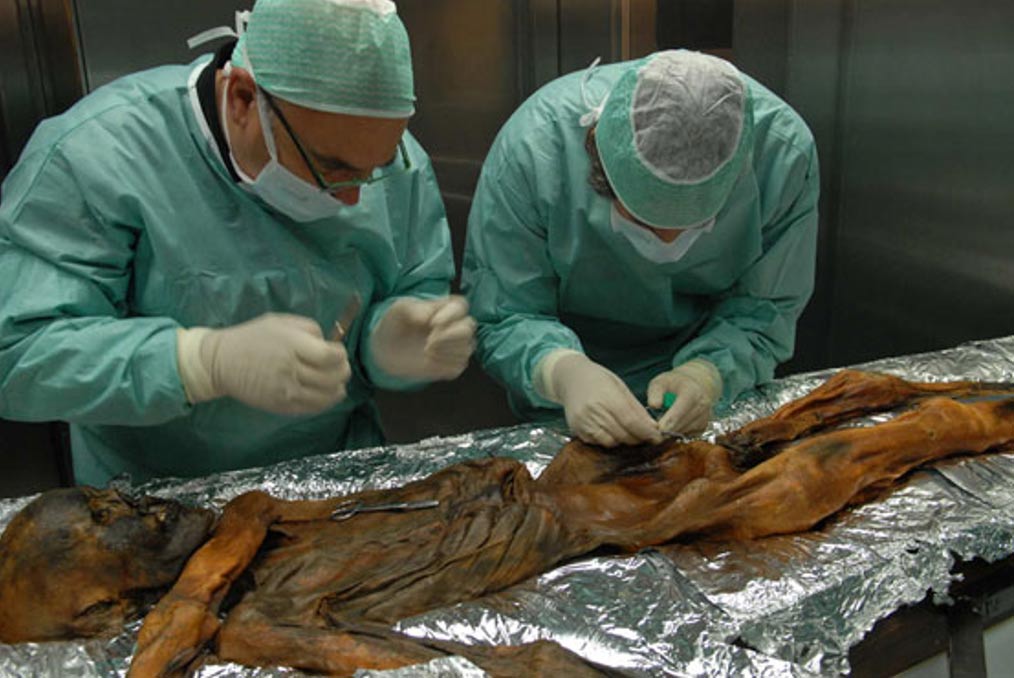5,300-Year-Old Otzi the Iceman Yields Oldest Known Human Blood
Researchers have found blood cells in the famous 5,300-year-old mummy found by hikers in the Austrian Alps years ago. A detailed analysis of his remains has also revealed that he would have died a quick death from his wounds. Ötzi the Iceman’s blood is the oldest known to science.
Ötzi was a victim of homicide. Researchers say he suffered a quick, violent death that was over quickly but may not have been painless, National Geographic reports. He had an arrow wound, but his death probably came from a blow to the back of his head.

A reconstruction of what Ötzi may have looked like (Thilo Parg/Wikimedia Commons)
No blood cells had been found in Ötzi since his discovery by German hikers in 1991 until recently. "There were no [blood] traces found, even when they opened some arteries, so it was thought maybe the blood had not preserved and had completely degraded, or that he lost too much blood because of the arrow injury" on his back, Albert Zink, head of the Institute for Mummies and the Iceman in Bolzano, Italy, told National Geographic. Zink is a member of the team doing research on Ötzi’s corpse.
However, using a nano-size probe, researchers spotted the distinctive doughnut shape of red-blood cells near the arrow wound and a cut on his right hand. They recorded the movements of the probe with a laser to get a three-dimensional image of the cells. The researchers also shone lasers on the wounds to reveal the molecular makeup of the substance to confirm it was indeed blood.
- Otzi's non-human DNA: Opportunistic pathogen discovered in ancient Iceman
- Scientists discover new tattoos on 5,300-year-old Otzi the Iceman mummy
- Were the tattoos of Ötzi the iceman therapeutic?

Oldest known human blood cell found in Ötzi. (Image courtesy Marek Janko)
The nanotechnology probe and a high-powered microscope also revealed traces of fibrin, a clotting agent in human blood, which suggests he would have died quickly.
"There were still some people arguing that he survived the arrow maybe a few hours or a few days, but this was definitely not true," Zink told National Geographic. "Fibrin is formed immediately when you get a wound, within a few minutes, but then it disappears [in a living body]. Finding fibrin in the arrow wound is confirmation that Ötzi actually died very quickly after the arrowshot."
This is just the latest of many years of post-mortem studies on Ötzi’s body. Scientists in June 2014 decoded Ötzi’s genome from a hip bone sample. However the tiny sample weighing no more than 0.1 g provides so much more information. A team of scientists from EURAC in Bolzano/Bozen together with colleagues from the University of Vienna successfully analyzed the non-human DNA in the sample. They found evidence for the presence of Treponema denticola, an opportunistic pathogen involved in the development of periodontal disease. Thus, by just looking at the DNA, the researchers could support a CT-based diagnosis made last year which indicated that the Iceman suffered from periodontitis.
In another study, researchers speculated that the tattoos that covered his body were therapeutic, an early form of acupuncture.

A cross-shaped tattoo on Otzi's knee. Photo source.
Ötzi’s body art, the only known example of Copper Age tattoos, includes 50 tattoos across the body, most of which are formed of lines and crosses which were made by making small incisions in the skin and then rubbing them with charcoal.
“Radiological images of the tattooed areas show degenerative areas under the tattoos that could have caused pain,” a spokesman for the South Tyrol Museum of Archaeology said in 2013. “As the tattooing spots lie approximately over the acupuncture medians, it seems common opinion that they could have been use for that.”
Ötzi’s tattoos were found on all the parts of the body that showed evidence of wear and tear, including his ankles, wrists, knees, Achilles tendon, and lower back, leading the researchers to suspect that the tattoos were used therapeutically to relieve ailments like rheumatism and arthritis. If this is true, then this could constitute the earliest form of acupuncture, which was thought to have been invented more than 2,000 years later in Asia.
Featured image: Researchers take a sample from Iceman's hip in 2014. Image credit: Samadelli Marco/EURAC
By Mark Miller




















Comments
Who knows? Maybe he was a special person or a king.
নাঈম
This man never knew how famous he would be after he died. I wonder if the cut on his hand was a self defense cut while he was battling off an adversary. If so, another adversary could have taken advantage of the fight to shoot Otzi in the back with an arrow. The only thing worth stealing, I would think, would be Otsi's flock or herd ....so I guess that's why the poor guy was murdered.